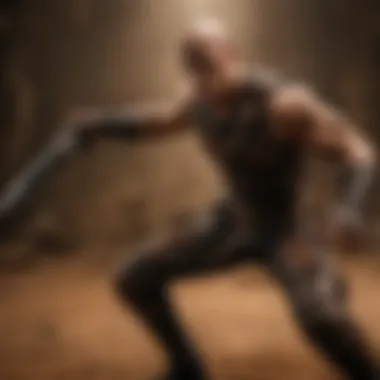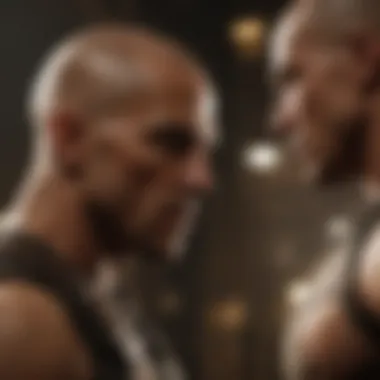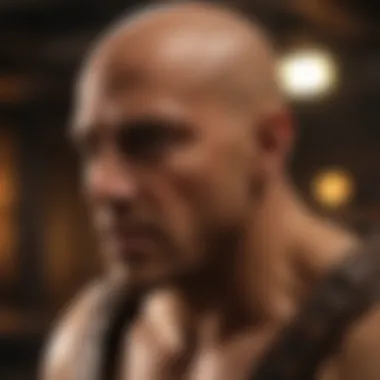Riddick: An Insightful Look at the 2013 Film


Intro
The world of science fiction often serves as a fertile ground for exploring humanity's insecurities and dreams. One such universe lies within the film Riddick, released in 2013. This cinematic work adds another layer to a character that started as a villain and evolved into a complex anti-hero.
David Twohy, the director and co-writer of this installment, takes audiences on a dark journey through desolate landscapes, engaging not only with the surface-level action but also layers of survival and the nature of identity itself. The film stands as a unique combination of the action and horror genres, while simultaneously paying homage to its predecessors. In examining Riddick, we can begin to unravel its narrative intricacies and explore the gritty world it presents.
Prelude to Riddick
The Riddick franchise is a standout example of how science fiction can intertwine with intense character development and complex themes. Not only does this series explore the depths of its titular character, but it also shines a light on broader constructs such as survival instincts, morality, and the gray space between good and evil. Diving into the details of Riddick (2013) isn’t merely an examination of a film; it’s akin to peeling back layers of an onion, revealing the intricate threads that weave through the narrative and its rich universe.
Understanding the importance of this segment is key to grasping the entire essence of the film. The analysis of Riddick in this article aims to clear up why the film is a significant pivot point within the franchise and in science fiction filmmaking overall. It sets the tone, emphasizing that no detail is too small when trying to comprehend a work that resonates with both die-hard fans and casual observers alike.
Overview of the Riddick Franchise
The Riddick franchise began with Pitch Black in 2000, introducing audiences to the anti-hero Richard B. Riddick, played by Vin Diesel. This initial entry was a mix of horror and sci-fi, establishing a cult following primarily due to its innovative approach to storytelling and visuals. With the release of The Chronicles of Riddick in 2004, the narrative expanded, diving into Riddick's backstory and the wider universe he inhabits. Despite mixed reviews, the world-building elements laid a foundation for future developments of the series.
Riddick (2013) returns to the series' roots, stripping back the grandiosity of its predecessor and focusing on pure survival and character depth. The film merges elements from earlier entries while providing a fresh perspective that appeals to both old fans and newcomers. There's something to be said for its gritty atmosphere and direct narrative—which often feels raw compared to the stylized chaos of earlier films.
Context of the Release
When Riddick hit theaters in 2013, it served not only as a continuation of the story but also as a response to the evolving landscape of science fiction films. The early 2010s were marked by franchise overload, with big-budget blockbusters dominating the box office. In this environment, Riddick aimed to offer something stark and uncompromising amid a sea of polished spectacles.
The film stood out due to its focus on isolation and survival—a man against nature, if you will. As it hits the screen, it's clear that it's an answer to the fatigue of overly complicated storylines or forced narratives. Despite its budget constraints, the film's starkness was a refreshing slap in the face to the genre, showcasing that compelling storytelling doesn’t always require a hefty financial backing.
In short, exploring the context around Riddick reveals not just how it fits within its franchise but also how it engages with broader cinematic trends and expectations from audiences looking for substance over spectacle.
Plot Summary
The importance of a plot summary in the context of this article is manifold. It functions as a foundational element that elucidates the core narrative woven throughout Riddick. By dissecting the key plot points, readers can gain insight into the film's structure and its unfolding drama. This section not only highlights essential story elements but also sets the stage for analyzing character arcs and thematic depth, enriching the overall understanding of the film’s contribution to the larger Riddick universe.
Major Plot Points
Riddick picks up where its predecessor, The Chronicles of Riddick, left off, thrusting viewers into a harsh and unforgiving landscape. The film opens with Riddick, played by Vin Diesel, in a desolate alien world, fighting to survive against both the savage creatures of the planet and the consequences of his past actions. This initial setup is crucial, signaling to the audience that this installment will focus on survival and primal instincts rather than interplanetary politics.
Riddick’s struggle begins when he is betrayed by those he considered allies. This betrayal sets the tone for a relentless fight for survival, pushing him to activate a distress beacon that leads mercenaries to his location. It is here that the film's tension escalates, providing a backdrop for the multifaceted interactions between Riddick and the various bounty hunters. Key moments include bloody confrontations where Riddick's strategic prowess shines, highlighting his intelligence and instinctual combat skills. This evolving cat-and-mouse game underlines the film's essence, balancing horror and action while maintaining a visceral atmosphere of dread.
Character Arcs
The character arcs in Riddick are intricately connected to the major plot points and serve as a reflection of the film's exploration into themes of survival and morality. Riddick himself is portrayed less as a traditional hero and more as a complex anti-hero grappling with his brutal past. Unlike typical protagonists, he often uses cunning and violence to navigate situations, leading to moments where viewers question their allegiance and empathy towards him.
Supporting characters, such as Locke and Dahl, further enrich the narrative. Locke, played by Matt Nable, is a determined bounty hunter whose motivations begin to blur throughout the film. The audience sees him gradually transition from predator to a character that hints at understanding Riddick's plight, prompting discussions about the morality of revenge and justice. Dahl, played by Katie Sackhoff, offers a contrasting perspective; her arc reflects resilience and adaptability as she shifts from suspicion to perhaps even admiration for Riddick.
The complexity of character interactions in Riddick serves to question traditional binary notions of good versus evil, presenting an ambiguous moral landscape.


Overall, the plot and character arcs work in tandem to create a layered storytelling experience, compelling audiences to not only engage with the thrilling action but also with deeper, often philosophical questions about nature, freedom, and what it means to be a monster or a hero.
Thematic Considerations
The film Riddick is not just a visual spectacle; it dives into the psyche of its characters and the world they inhabit. Thematic considerations in this movie pave the way for a deeper understanding of its narrative. By examining themes like survival, isolation, and the moral complexity of anti-heroism, one can appreciate how these layers enrich the viewing experience. Each theme intertwines to create a tapestry that speaks to various aspects of human nature and society. The significance of these themes is paramount, as they resonate with our innate struggles and moral dilemmas, making the film more relatable and thought-provoking for the audience.
Survival and Isolation
In a bleak and hostile universe, survival becomes the name of the game. The character of Riddick embodies this struggle, navigating relentless threats from both the environment and human foes. One could argue that his survival skills are not merely about physical prowess but also about mental fortitude. The isolation he experiences shapes his identity, pushing him into a solitary existence where he relies solely on his instincts. This theme of isolation is reinforced through cinematic techniques, utilizing barren landscapes and limited dialogue to portray his solitude.
As viewers, we're pulled into the visceral experience of survival that Riddick faces daily. This moment-to-moment struggle highlights not only his resourcefulness but also what it means to be human in dire circumstances. The film taps into an age-old narrative: the fight for existence against overwhelming odds, and it does so with a rawness that captivates the audience. The cinematography plays a crucial role here, using stark contrasts and shadows which mirror Riddick’s inner turmoil. It’s a gut-wrenching reminder of what loneliness can do to a person and how one’s will to survive becomes a defining characteristic.
Morality and Anti-Heroism
Riddick stands as a symbol of the anti-hero, a figure who doesn't fit neatly into the confines of good and evil. In his world, morality isn’t black and white; it’s a swirling gray that challenges traditional views of heroism. He's not driven by altruism but rather by a primal code that’s often misunderstood. This theme digs into the complexity of morality—what drives someone to commit heinous acts or act heroically in one fell swoop?
The evolution of Riddick’s character through the franchise adds layers to this exploration. He’s ruthless when needed, yet he possesses a sense of honor that complicates his actions. Viewers wrestle with their feelings towards him—can a character involved in violence be deemed worthy of sympathy? This question resonates deeply and encourages a reassessment of our own moral frameworks.
"Anti-heroes invite us to reconsider our perceptions of right and wrong, pushing us to see humanity even in flawed beings."
Ultimately, Riddick challenges the audience to think beyond the conventional hero narrative. The film forces a confrontation with uncomfortable truths about human nature, morality, and survival instinct. In this deeply layered narrative, both survival and anti-heroism merge, revealing the darker sides of our motivations and the resilience of the human spirit.
Cinematic Techniques
Cinematic techniques are the brushstrokes of a filmmaker's canvas. In the realm of Riddick, they serve not just as embellishments, but as the very heartbeat of the narrative. The way that a scene is visually crafted or how sound is used can fundamentally alter the audience's perception and experience of a film. Understanding these techniques can greatly enhance our appreciation for the film’s artistry and storytelling.
Visual Aesthetics
Visual aesthetics in Riddick play a crucial role in establishing the film's atmosphere and mood. From the barren alien landscapes to the slick, shadowy interiors, each visual element is designed to envelop the viewer in Riddick's world. The cinematography, spearheaded by David Eggby, employs a palette that ranges from vibrant hues to muted tones, which reflects the protagonist’s isolation and struggle for survival.
- Color Grading: The use of color grading is particularly significant, as it helps to communicate the narrative's emotional undertones. For example, the cold blues and greens capture the starkness of the alien planet, while warmer tones emerge during moments of action or conflict.
- Framing and Composition: The framing of shots adds depth to the storytelling; tight zooms on Riddick amplify his solitary state, while wide shots of the surroundings enhance the sense of vulnerability in an expansive, ruthless environment.
As the character navigates through this hostile territory, the viewer is visually anchored in both his physical struggles and emotional battles.
Sound Design and Score
Sound design in Riddick is another layer that immerses the audience in the film's universe. The collaboration between sound designers and composers shapes the psychological landscape of the movie. The soundscapes, created by a blend of natural and synthetic sounds, breathe life into the desolate setting and forge a connection with Riddick’s primal instincts.
- Ambient Sounds: The use of ambient sounds, like the distant echoes of alien wildlife or the crunch of gravel underfoot, establishes an almost tangible reality. They draw viewers into Riddick’s experience, making the environment feel alive and threatening.
- Musical Score: The score, crafted by the renowned composing duo of Graeme Revell, accentuates the tension and drama of key moments. It fluctuates between haunting melodies and intense crescendos, drawing viewers further into Riddick's harrowing journey. The interplay between silence and sound is particularly noteworthy; a moment of calm can quickly be shattered by an explosive orchestral moment, paralleling the unpredictability of the narrative itself.
Directorial Style of David Twohy
David Twohy's directorial style unifies the film's components, steering Riddick into darker territory. Twohy’s propensity for intricate world-building and tension-driven narratives has solidified his place in the genre, and this film offers a template of his strengths.


- Narrative Pacing: Twohy balances tension and relief in a way that keeps the audience engaged without feeling overwhelmed. He knows when to linger on a moment to build suspense and when to draw the viewer swiftly into action. This ebb and flow characterize the film’s gripping quality.
- Character-Driven Storytelling: His commitment to character development ensures that every visual and auditory cue reinforces Riddick's identity as a reluctant anti-hero. Moments of silence or vulnerability are just as vital as the action sequences, adding layers to his character that resonate with audiences.
A well-placed shot, a nuanced sound, all coalesce under Twohy’s vision, forging a narrative that remains memorable long after the credits roll.
In summary, the cinematic techniques employed in Riddick serve to deepen the viewer’s engagement with its themes, characters, and story. Through meticulous visual aesthetics, immersive sound design, and Twohy's distinctive direction, the film stands as a testament to the power of cinema as both an art form and a storytelling medium.
Critical Reception
The reception of a film often serves as a barometer for its success: not just financially but also in the hearts and minds of its viewers. When it comes to Riddick, released in 2013, understanding its critical reception is paramount for grasping its significance in the wider landscape of science fiction cinema. This section delves into box office performance, audience reviews, and critical analysis—each offering valuable insights into how Riddick was perceived by audiences and critics alike and why it matters.
Box Office Performance
On the financial front, Riddick had a challenging journey. With a production budget estimated around $38 million, it had a sturdy task ahead to drum up significant numbers. The film grossed approximately $98 million worldwide. A portion of this performance can be attributed to its dedicated fanbase who have followed the character of Riddick since his introduction in Pitch Black. However, the film's box office performance raised eyebrows—it was seen more as a modest return than a smashing success.
- Factors influencing box office performance include:
- The timing of the release: launched in a competitive season.
- Marketing strategy: perhaps fighting against the shadows of larger blockbusters.
- The loyalty of established fans vs new audiences: often a gamble.
Despite these challenges, the film did secure its place in the annals of genre filmmaking. The numbers show that, while it may not have broken bank records, it certainly kept Riddick relevant.
Audience Reviews
Looking at audience reviews, one might see a divided opinion. Many fans of the franchise appreciated the film’s return to the darker, gritty narrative that defined the original installments. Comments on platforms like Reddit reveal a blend of nostalgia and new excitement.
"Riddick takes us back to where it all began - in the dark, wild. It’s like reuniting with an old friend who you forgot how much you missed."
However, new viewers often found themselves confused by plot threads that didn’t tie neatly to their expectations. Some called it unpredictable, others labeled it lonely—a term often applied to the film's overall feel as it traversed themes of isolation and self-discovery.
Critical Analysis
Critical reviews of Riddick vary widely, serving as a reflection of the broader themes the film struggles with. Critics praised the return to its roots, highlighting David Twohy's direction as a nod to the film’s origins. They noted that the cinematic visuals, especially in the alien landscapes, were a feast for the eyes, capturing an uncompromising portrayal of a brutal world.
However, not all reviews were glowing.
- Key points from critical reviews include:
- Many pointed out that the story leaned heavily on established tropes.
- The pacing was critiqued as uneven, jumping from slow moments to high-intensity scenes without smooth transitions.
- The character development for the supporting cast was seen as lacking, overshadowed by Riddick's screen presence.
Overall, the critical reception encapsulated the film as a rich yet flawed entry in the franchise. The balance between fan service and mainstream appeal remains a topic in discussions of its legacy. This complexity in reactions is what makes examining Riddick particularly interesting, revealing the layered relationship between a film and its audience.
Character Analysis
In the realm of cinema, characters often serve as vessels through which audiences can explore complex themes and moral quandaries. The character analysis in Riddick is pivotal not merely for understanding the narrative but also for dissecting its intricate undercurrents. This examination uncovers the motivations, transformations, and interactions that shape the film's atmosphere, providing insight into both protagonist and antagonist alike. In a genre like science fiction, where imaginative worlds can obscure relatable human experiences, the efficacy of characters becomes all the more critical in grounding the story.


Riddick: The Anti-Hero
Riddick, played by Vin Diesel, stands as one of the definitive anti-heroes of modern cinema. His character is not merely a collection of rugged traits; rather, he embodies an enigmatic quality that captivates the audience while raising moral questions. At first glance, Riddick appears to be a brute, a merciless killer navigating a ruthless universe. However, a closer inspection reveals layers that encapsulate themes of survival and instinctual behavior driven by past traumas. His infamous line, “You keep what you kill,” underscores a simplistic yet profound moral compass that guides him in a world defined by treachery.
Riddick's struggle against external forces—a tidal wave of bounty hunters chasing after him—and his internal quest for purpose encapsulate his duality. He is both predator and prey, which complicates viewer sympathies. Amidst bloodshed and chaos, he showcases an almost childlike yearning for connection, as illustrated in his interactions with the
Cultural Impact
Understanding the cultural impact of Riddick (2013) goes beyond just appreciation of its narrative; it encapsulates how the film resonates within the broader context of the science fiction genre and the Riddick franchise itself. The film is an extension of a universe that has seen a steady evolution since Pitch Black in 2000, consistently pushing boundaries and redefining elements typical in sci-fi narratives. Fans appreciate how Riddick not only continues the storyline of Richard B. Riddick but also asserts its own identity in a landscape crowded with films vying for attention.
The impact can be broken down into two main areas: influence on genre conventions and community engagement.
Influence on the Science Fiction Genre
The Riddick franchise has carved out a niche for itself in science fiction, often playing with tropes in unexpected ways. The 2013 installment doesn’t shy away from embracing the elements of action, horror, and even existential philosophy that are prevalent throughout the genre. Its intricate world-building, completed with striking visuals and chaotic survival scenarios, creates a framework that resonates well with both genre veterans and newcomers.
- It challenges the commonly accepted notions of heroism, presenting Riddick as a sympathetic anti-hero battling against overwhelming odds, a stark contrast to sanitized protagonists in other films.
- The fusion of gritty realism and fantastical elements allows the audience to embrace the absurdity of the events without losing sight of the film's underlying messages.
"Specific elements of Riddick carve a space in the minds of viewers, keeping them invested in the outcome of an anti-hero’s struggle against his internal demons and external threats."
Fandom and Community Engagement
The cultural impact of Riddick is starkly evident in its dedicated fandom. The film has fostered a community that engages in spirited discussions, theory crafting, and fan art. Several elements contribute to this vibrant community:
- Social media platforms like Reddit and Facebook have become hubs where fans share insights about plot twists and character developments.
- Fans have developed a passion for cosplaying various characters from the franchise, showcasing creative interpretations that bring to life different aspects of Riddick’s universe.
- The film's somewhat ambiguous ending left room for speculation, inciting various discussions and analyses among enthusiasts.
All of these components interlink to create a rich tapestry, one that enhances the overall experience surrounding Riddick. Through fan engagement, it continues to thrive well beyond its release date, demonstrating how persistent narratives command a lasting presence in popular culture. By fostering engagement and attracting a broad audience, Riddick has solidified its position within not only the sci-fi realm but in the heart of its fanbase.
Closure
As we draw the curtain on the exploration of Riddick, it's clear that the film holds a significant place within the cinematic landscape of science fiction. This flick goes beyond just being another entry in the franchise; it encapsulates the essence of isolation, survival, and the complexity of its titular character. The discussions we've had on its themes, character arcs, and unique cinematic techniques serve not just to dissect a single movie but to illuminate the broader implications of its narrative structure.
Legacy of Riddick
The legacy of Riddick is multi-faceted. Released in 2013, it expanded upon the foundations laid by its predecessors, Pitch Black and The Chronicles of Riddick. The film did much more than merely ride the coattails of earlier success; it introduced new characters and complexities to Riddick's world, emphasizing his lone-wolf persona.
Fans often regard it as a return to form, notably because it revisits the gritty, survival-centric tone that was so compelling in Pitch Black. The film's legacy is solidified in the characteristics it reinforces:
- Enhanced Narrative Depth: It draws viewers into Riddick's psyche, focusing on the struggle between man and nature, and revealing his inner turmoil.
- Sight and Sound Alignment: The strong visuals and sound design fuse together seamlessly, immersing the audience in the bleak landscapes.
- Cult Following: Over the years, it has cultivated a diverse fanbase eager to dissect Riddick's complexities and the universe he inhabits.
In essence, Riddick serves as both a homage to and an evolution of science fiction cinema, securing its position in discussions about the genre.
Future of the Franchise
Looking down the road, the future of the Riddick franchise seems promising but uncertain. The character's journey has inspired interest in potential sequels or spin-offs, each holding the promise of exploring uncharted territories within this fascinating universe. Several factors could influence the next steps:
- Audience Demand: The film's engaging narrative has kept fans anticipating more adventures with Riddick.
- Creative Direction: David Twohy’s vision for the character and story is critical. His return as a director could maintain or enhance the franchise's integrity.
- Industry Trends: With the rise of streaming platforms, there are avenues for spin-off series that can flesh out other characters or world-building elements introduced in the films.
Ultimately, the Riddick saga—a conundrum of survival and moral ambiguity—continues to enthrall audiences. As new stories unfold, they may well deepen our understanding of what it means to be a survivor in an often unforgiving universe.







